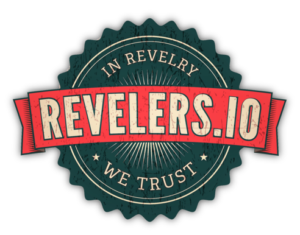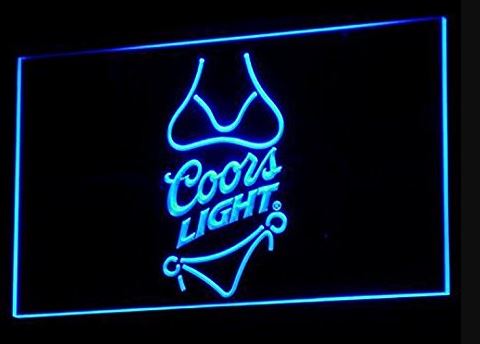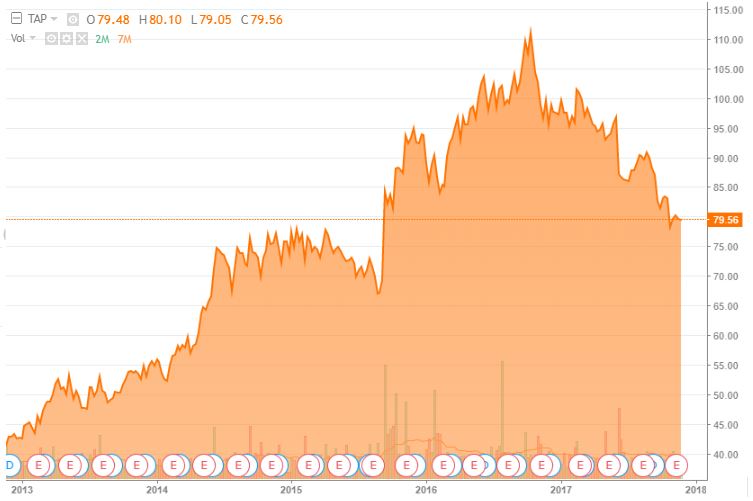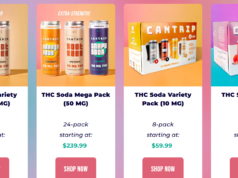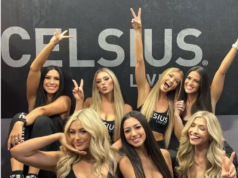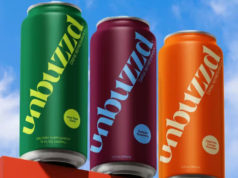5 YEAR CHART
Molson Coors Brewing Co. (NYSE:TAP)
Q3 2017 Earnings Call
November 01, 2017 11:00 am ET
Executives
Mark R. Hunter – Molson Coors Brewing Co.
Tracey Joubert – Molson Coors Brewing Co.
Gavin Hattersley – Molson Coors Brewing Co.
Simon Cox – Molson Coors Brewing Co.
Analysts
Andrea F. Teixeira – JPMorgan Securities LLC
Laurent Grandet – Credit Suisse Securities (NYSE:USA) LLC
Vivien Azer – Cowen & Co. LLC
Robert Ottenstein – Evercore Group LLC
Judy Hong – Goldman Sachs & Co. LLC
Mark David Swartzberg – Stifel, Nicolaus & Co., Inc.
Bryan D. Spillane – Bank of America-Merrill Lynch
Tristan van Strien – Redburn (Europe) Ltd.
Pablo Zuanic – Susquehanna Financial Group LLLP
Mark R. Hunter – Molson Coors Brewing Co.
Thank you, Rachel, and hello and welcome, everybody, to the Molson Coors earnings call and many thanks for joining us today. With me in the call this morning from Molson Coors, we have Tracey Joubert, our Global CFO; Gavin Hattersley, the CEO of our U.S. business; Fred Landtmeters, our Canada CEO; Simon Cox, the CEO of our Europe business; Stewart Glendinning, our International CEO; Sam Walker, our Global Chief Legal and Corporate Affairs Officer; Brian Tabolt, our Global Controller; and Dave Dunnewald, our Global VP of Investor Relations.
Today, Tracey and I will take you through the highlights of our third quarter and year-to-date results, along with some perspective regarding the balance of 2017. Consistent with last quarter, we’re also offering slides that show both reported and constant-currency results for both the quarter and year-to-date. You can view and follow along with these slides using the link on the Investor Relations page of our website.
The Molson Coors Brewing Company will deliver growth and long-term shareholder value through our first choice for consumer and customer approach, an expanded international business, the delivery of integration savings, ongoing cost savings, a more efficient global organization and a relentless drive for financial performance.
Our focus is to deliver both top and bottom line growth. Year-to-date, we’ve delivered worldwide brand volume growth, driven by our global priority brands. And on a constant-currency basis, NSR per hectoliter is up 2.4% as our portfolio premiumization has driven pricing and mix benefits around the globe.
To this point, in terms of progress, above-premium brand volumes increased 19% in the quarter and 20% for the year. And with this strong growth, our above-premium brands now represent 18% of our total volumes. At the same time, we’ve improved our EBITDA margins this year while investing in the business, with underlying EBITDA margins up by nearly 40 basis points year-to-date.
Our 2017 underlying free cash flow generation has been strong. We begun delevering our balance sheet and we’re generating cost savings ahead of our plan, which has helped to mitigate higher-than-anticipated input cost inflation.
Now, a question I get when I talk with investors is, how we prioritize our top and bottom line goals? And the management team and our board address this important point as follows. We, first, will drive margin expansion and bottom line growth by delivering cost savings, ensuring efficient brand investments and paying down debt. Second, we will drive an improved top line through our commercial excellence approach, which provides a more sustainable source of profit growth over the medium to long term. This is our order of priority. Additionally, we will maintain our profit focus and our continued drive for total shareholder return through PACC or profit after capital charge, which is our capital allocation tool.
So, one year on from the close of the MillerCoors transaction, the bigger, better and stronger Molson Coors is driving a cohesive and distinctive First Choice commercial agenda, an expanded international business, a more efficient global organization and a relentless focus on financial performance, all underpinned by highly engaged employees who are playing to win.
And with that as a backdrop, I’ll now turn over to Tracey to give financial highlights.
Tracey Joubert – Molson Coors Brewing Co.
Thank you, Mark, and hello, everybody. So, let’s review our consolidated financial headlines for the third quarter versus our pro forma results a year ago, except for cash flow, which is reported on a year-to-date actual basis.
Our net sales decreased 2.1% due to lower financial volumes, partially offset by positive global pricing, sales mix, royalty volume and foreign currency movements. Our net sales in constant currency declined 3%. Our global net sales per hectoliter increased 2.9% and 1.9% in constant currency, due to higher global pricing and sales mix.
Our worldwide total brand volume increased 0.6%, driven by strong growth in Europe and International, partially as a result of adding the Miller global brands business and also from growth in some of our core brands. Our global priority brand volume increased 2.4%.
Our financial volume decreased 4.8%, driven by the U.S. and Canada, which were adversely impacted by reductions in wholesaler inventories, contract brewing and brand volumes. These volume declines were partially offset by growth in both Europe and International due to added Miller International brand volumes as well as positive organic brand performance.
U.S. net income increased (sic) [decreased] 12.1% and underlying non-GAAP net income decreased 3.5%. Our underlying results were primarily attributable to lower financial volume, higher brand amortization expense, increased G&A costs and a higher effective tax rate, partially offset by positive pricing and mix, cost savings and lower interest expense.
Our underlying EBITDA decreased 1.2% on a constant-currency basis. Our underlying free cash flow compared to actual results last year increased nearly 80%, driven by the addition of the other 58% of MillerCoors cash flows as well as lower cash tax paid for taxes, which were partially offset by higher cash paid for interest and capital expenditures.
We ended the quarter with net debt of $11.3 billion and we made an additional discretionary contribution of $200 million to our U.S. defined-benefit pension plan in the third quarter as part of our deleveraging goals, bringing our total cash contributions to approximately $310 million for the year. We remain committed to investment-grade debt ratings and reducing our leverage ratio to about 4 times on a rating-agency basis by the end of 2018.
Year-to-date, we improved underlying EBITDA by 1.8% in constant currency, with strong NSR per hectoliter growth and total worldwide brand volume up 1.6%.
And now, I’d like to share some regional highlights from the third quarter. In the U.S., we grew underlying EBITDA 0.8% on a pro forma basis in the quarter, resulting from increased domestic NSR per hectoliter, driven by higher net pricing as well as cost savings and lower MG&A expenses, partially offset by the impact of lower shipment volumes.
Overall, U.S. STRs declined 2.9% for the quarter on a trading-day-adjusted basis, in part because the U.S. volume environment remains challenging. Our domestic sales to wholesalers declined 7.2%, with nearly two-thirds of the gap between STRs and STWs driven by a reduction in distributor inventories and the rest due to one less trading day this quarter. Distributor inventories were reduced in the third quarter following higher-than-planned levels at the end of the second quarter.
Our year-to-date U.S. performance was similar to the third quarter, with a 2.2% increase in underlying EBITDA, 0.8% higher NSR per hectoliter and a 2.3% decline in STR volume. Despite the difficult backdrop, we made progress this quarter against our portfolio strategy, as Mark will share with you shortly.
